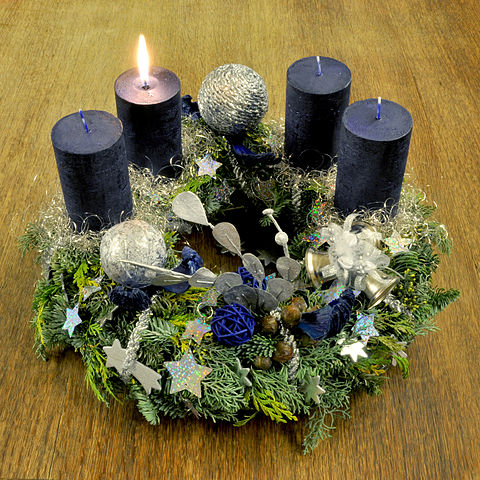
Photo :Micha L. Rieser(Wikimedia Comos)
Advent is not just a countdown till Christmas but an important part of the liturgical year in preparation for the birth of Jesus. Roman Catholics, Eastern Orthodox, Anglicans and other Christian denominations observe this special time. Advent is a short period of only four weeks (Sundays and weekdays) leading up to Christmas Day. Usually, Advent begins on or after the feast of St. Andrew the Apostle on 30 November. Eastern Orthodox uses the Julian calendar for their liturgical year, so they start 13 days after the current Gregorian calendar date.
The word Advent comes Latin word adventus, meaning coming or coming to, is a time of preparation for the birth of Christ and a reminder that Jesus will return. Christians are reminded during this period to not be distracted or weighed down by all the commercialization that is going on around Christmas and focus on deepening their relationships with God. For Catholics it will be solemn masses, setting up Advent wreaths, reciting special prayers, and being more concerned about our fellow human beings. There are also special Advent songs and music that are used during this time as well.
Anglicans uses both traditional and modern rituals which include Advent processions, carols, and using Advent calendars (Catholics are doing this as well). Lutherans focus on God’s grace and his redemption. They incorporate Advent hymns, scripture, and lighting Advent candles as well. For Eastern Orthodox, it involves fasting until Christmas Day, daily prayers, and greatly anticipating the important event that is to come.
Whatever the denomination, Christians are preparing themselves for not only the birth of the savior but his return one day (the Final Judgment). So, it is a time of preparation, repentance, faith, and loving our fellow human beings. It also means to seek reconciliation through prayer and going to a priest or minister to get forgiven for our sins. Advent is not a time of merely counting down the clock and buying presents but spending time preparing for this important holy day that is to come. And a time to get closer to God as well.
Sources
Klein, Camilla. “Which Christian Denominations Celebrate Advent? – Christian Educators Academy.” Christian Educators Academy, 26 May 2023, www.christianeducatorsacademy.com/which-christian-denominations-celebrate-advent.
Infoplease. “Advent: Dates, Traditions, and History.” InfoPlease, 18 Nov. 2021, www.infoplease.com/culture-entertainment/holidays/advent-dates-traditions-and-history.
Staff, CNA. “What Is Advent Anyway?” Catholic News Agency, 1 Dec. 2023, www.catholicnewsagency.com/news/42900/what-is-advent-anyway-a-cna-explainer.
—. “The Beautiful Meaning and Purpose of Advent.” Crosswalk.com, 13 Nov. 2023, www.crosswalk.com/special-coverage/christmas-and-advent/the-beautiful-meaning-and-purpose-of-advent.html.

